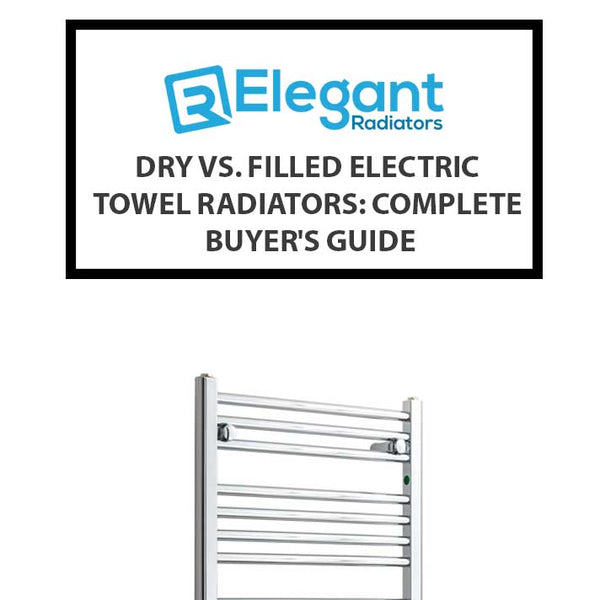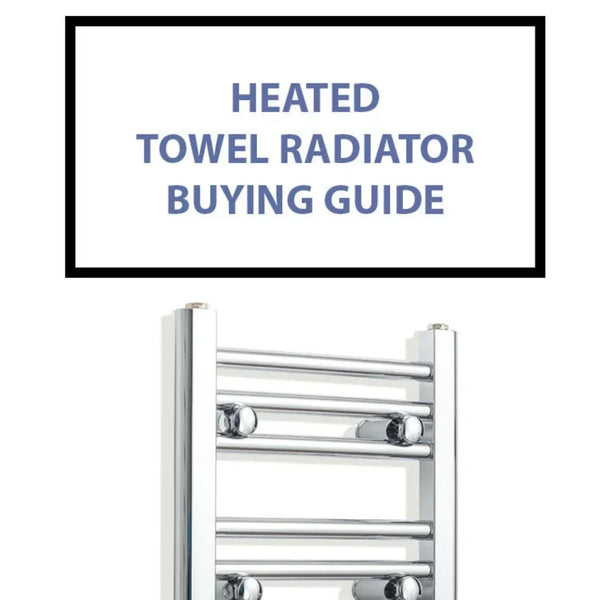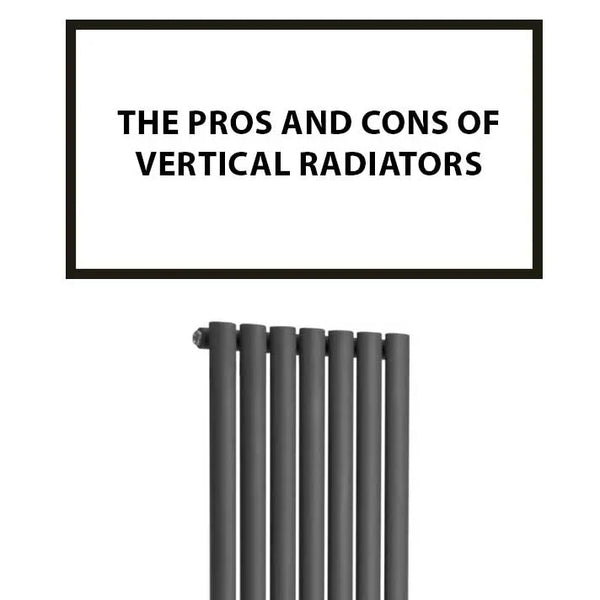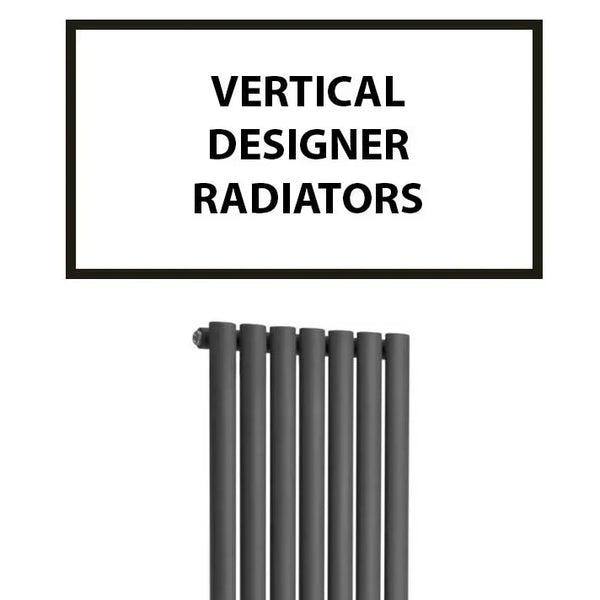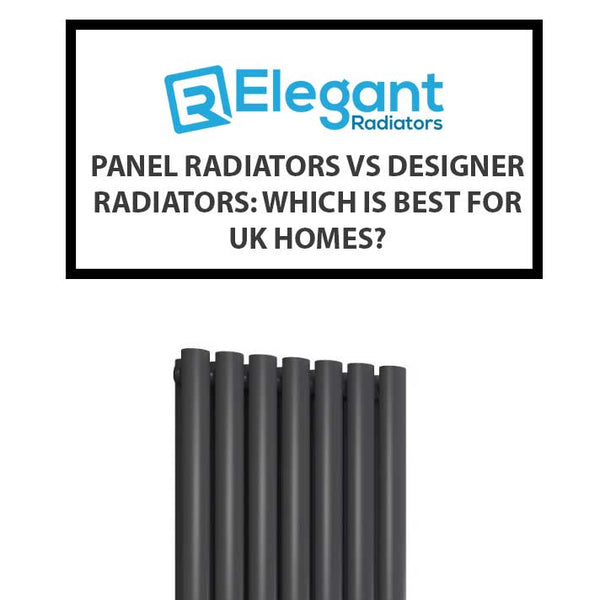The Pros and Cons of Vertical Radiators

Vertical radiators have surged in popularity, transforming from a niche "designer" item into a mainstream heating solution for savvy UK homeowners. They are no longer seen as purely functional, hidden objects, but as integral components of interior design. In fact, Google Trends data shows searches for "vertical radiator where to buy" have skyrocketed by 105% in a recent six-month period.
But are they all style and no substance? Or are they the perfect, space-saving solution for modern British homes?
This comprehensive guide will explore the detailed pros and cons, bust common myths about efficiency, and provide a practical guide to help you decide if a vertical radiator is the right choice for your home.
What Exactly is a Vertical Radiator?
A vertical radiator is simply a heating element that is taller than it is wide. It operates on the exact same principle as any other radiator in your central heating system: hot water circulates through it to radiate and convect heat into the room. They are specifically designed with features like vertical convection plates to move water effectively in this orientation and ensure even heat distribution.
The Pros: Why Choose a Vertical Radiator?
The benefits of vertical radiators go far beyond just looking good. They offer practical solutions to common design challenges in UK homes.
Pro: Unlock Your Home's True Potential with Space-Saving Design
This is, without a doubt, the single biggest advantage of a vertical radiator.
By utilising vertical height, they free up invaluable horizontal wall space. This is critical in smaller or unusually shaped UK rooms, especially in kitchens dominated by cabinets and bathrooms with limited free walls.
This isn't just "saving space"—it fundamentally changes a room's potential layout. You are no longer forced to arrange your furniture around a long, horizontal radiator. A sofa can finally be placed against the main wall, or a bookshelf can go where the old radiator used to be. The radiator is no longer an obstacle to design, but an enabler of it.
Pro: Transform Your Radiator from Utility to "Statement Piece"
Vertical radiators have evolved from functional items into striking design features that can define a room's aesthetic. They are available in a vast array of styles, from minimalist flat panels to traditional column designs and modern oval tubes.
The range of finishes is extensive, moving far beyond standard white to include popular choices like anthracite grey, black, chrome, and custom colours to integrate seamlessly with any decor. Some innovative designs even offer dual-purpose functionality, such as models with integrated mirrors (ideal for hallways) or those that function as heated towel rails in bathrooms.
Pro: Unmatched Placement Versatility
Their slim profile allows them to be installed in previously "dead" or unusable spaces. This includes narrow sections of a wall between windows or doors, behind a door, or in small alcoves. This versatility means you can bring heat to areas where a horizontal radiator would be impractical, such as hallways, landings, and stairwells, which are often the coldest parts of a home.
Pro: Potential to Add Property Value
While it may seem like a small change, high-quality designer radiators can give a home a more luxurious, modern, and considered feel. For potential buyers, this attention to detail can act as a unique selling point that increases the property's overall appeal.
The Cons: Critical Considerations Before You Buy
Despite their advantages, vertical radiators come with a specific set of challenges and costs that must be understood before you commit.
Con: The Financial Equation (It's More Than the Sticker Price)
Vertical radiators are typically more expensive than their horizontal counterparts, even for a similar BTU (heat) output. This premium is attributed to their "designer" status, the materials used, and often more complex manufacturing processes.
You can expect to see a clear price difference across market tiers:
- Budget (e.g., Flomasta, DuraTherm): £150 - £250
- Mid-Range (e.g., Milano Aruba, Lux Heat): £250 - £500
- Premium (e.g., Carisa, Designer Brands): £500+
Con: Installation is a "Small Renovation Project," Not a Simple Swap
Replacing a standard horizontal radiator with a vertical one is rarely a simple "like-for-like" exchange.
It almost always requires professional plumbing work to alter the existing pipework. This can involve lifting floorboards or chasing pipes into the walls, all of which add to the overall cost and disruption of the project. The total cost of ownership is not just the unit price; it's the unit price + professional installation + potential redecorating costs.
Con: The "Heavyweight" Problem: Wall Strength is Non-Negotiable
This is a critical, often-overlooked safety issue. Vertical radiators are significantly heavier than many horizontal models, with some weighing up to 58kg before being filled with water.
The wall you plan to mount it on must be strong enough to support this weight.
- Solid Brick Walls: These are ideal and generally have no problem.
- Plasterboard (Stud) Walls: Installation is possible, but it requires special, heavy-duty fixings that spread the load. Attempting this without the proper support is a common cause of failed DIY projects and can result in significant damage.
Con: Long-Term Maintenance Quirks
While not major drawbacks, they have unique maintenance needs:
- Bleeding: Air gets trapped in all radiators, but physics dictates that air rises. In a vertical radiator, this air naturally collects at the very top. While the bleeding process is standard, the bleed valve's high position means it can be harder to access and a more conscious maintenance task.
- Cleaning: While many sleek, flat-panel designs are easy to wipe down, their sheer height can make reaching the top to dust or clean a challenge.
The Great Debate: Are Vertical Radiators Less Efficient?
This is the most common and persistent myth surrounding vertical radiators.
The Misconception vs. The Physics
Let's be clear: a radiator's ability to heat a room is determined by its heat output, measured in British Thermal Units (BTU).
The idea that vertical radiators are inherently less efficient is a common misconception. If a vertical radiator has the correct BTU rating for your room's size, insulation, and heat-loss factors, it will heat the space just as effectively as a horizontal radiator with the same rating.
How Convection Really Works (Theory vs. Reality)
All radiators work through a combination of radiation and convection. Convection is the process where the radiator heats the air around it, which then rises, pulling in cooler air from the floor to create a circulation loop.
- The (Theoretical) Argument Against: Some argue that a vertical radiator's tall, narrow design creates a powerful column of hot air that rises directly to the ceiling. This heats the ceiling very efficiently but can be less efficient at heating the lower "living space" where you feel it.
- The (Practical) Reality: This academic debate is largely irrelevant in a real, furnished home. Why? Because the single biggest killer of radiator efficiency is obstruction.
Horizontal radiators are frequently placed in the worst possible spots—under windows, where they are then blocked by long curtains, sofas, or beds. This blockage traps the heat and effectively kills its convective ability.
A vertical radiator's height means it is far less likely to be obstructed by furniture.
The Verdict on Efficiency
In a typical, furnished UK room, an unblocked vertical radiator will often provide better practical heat distribution than a (theoretically superior but) blocked horizontal one.
The golden rule is not about orientation, it's about: Correct BTU + Strategic, Unblocked Placement.
Material Matters: Steel vs. Aluminium vs. Stainless Steel
The material your radiator is made from has a significant impact on its performance, cost, and longevity.
- Mild Steel (The Industry Standard): This is the most common and budget-friendly option. It's strong and durable. It heats up slower but also cools down slower (known as high thermal inertia), meaning it continues to release a steady, residual heat even after the boiler switches off.
- Aluminium (The Responsive & Efficient Choice): A lightweight, premium material. It's an exceptional thermal conductor, heating up significantly faster than steel (up to 5 times faster) and requiring less water to do so. This makes it highly responsive and energy-efficient. However, it also cools down very quickly once the heating is off. Its efficiency makes it ideal for low-temperature systems like heat pumps.
- Stainless Steel (The Premium & Durable Option): A high-cost option known for its exceptional durability and resistance to rust and corrosion. It has heat retention properties similar to mild steel but offers superior longevity. It's often chosen for its aesthetic qualities, such as a polished or brushed finish.
| Feature | Aluminium | Mild Steel |
|---|---|---|
| Heat-Up Speed | Very Fast (High Responsiveness) | Slower (High Thermal Inertia) |
| Heat Retention | Low (Cools down fast) | High (Stays warm longer) |
| Weight | Lightweight (Easier install) | Heavy (Needs robust fixings) |
| Initial Cost | Higher | Lower (More budget-friendly) |
| Energy Efficiency | Very High (Less water, fast heat) | Good (Standard efficiency) |
| Best For... | Quick heating, intermittent use rooms, heat pumps | Steady, consistent heat, budget projects |
How to Choose, Size, and Place Your Vertical Radiator
Getting this right is crucial for performance.
Sizing: Your Non-Negotiable First Step
Guessing the size (BTU) is the biggest mistake a homeowner can make.
- Undersized: The radiator will never properly heat the room, no matter how long it's on.
- Oversized: You'll be paying for heat you don't need, leading to higher bills.
Always use an online BTU calculator. You will need these key inputs:
- Room Dimensions: Length, width, and especially ceiling height. High ceilings significantly increase the room's volume and BTU requirement, a key factor for vertical radiators often chosen for these spaces.
- Windows: The number, size, and type of glazing (single, double).
- Walls: The number of external walls and their construction (e.g., solid brick, insulated cavity).
- Room Factors: What is above and below the room (e.g., another heated room vs. an uninsulated roof).
Pro Tip: Always oversize slightly (e.g., by 10%). You can always turn a radiator down with a Thermostatic Radiator Valve (TRV), but you can't make an undersized one work any harder.
Placement: The Golden Rules
While the old rule of placing radiators under windows to combat draughts is less critical with modern double glazing, new rules apply:
- Rule #1: AVOID BLOCKAGES. This is the most important rule. Never install any radiator, vertical or horizontal, behind large furniture like sofas, cabinets, or thick, floor-length curtains.
- Rule #2: Consider Room Function. In a kitchen, place it away from appliances like the fridge or oven to prevent the thermostat from getting false readings. In a bathroom, proximity to the shower or bath is key for warm towels.
- Rule #3: Use Internal Walls. If possible, mounting a radiator on an internal wall can reduce heat loss to the outside and improve efficiency.
Final Verdict: Is a Vertical Radiator Right for You?
The vertical radiator has firmly established itself as a key player in the UK heating market. It is no longer just a "fashion" item but a powerful tool for interior design and spatial optimisation.
The core decision comes down to a clear trade-off: vertical radiators offer unparalleled advantages in style and space-saving versatility, but this comes at a premium for both the unit itself and the complexity of installation.
Their performance is excellent, if they are sized and placed correctly.
Expert Recommendations:
- For the Modern Apartment Owner with Limited Space: A vertical radiator is almost an essential choice. The space-saving benefits in a compact kitchen or living area are transformative and well worth the investment. An aluminium model is recommended for its fast heat-up times in smaller, well-insulated spaces.
- For the Period Property Renovator: A vertical column radiator can be a stunning choice, blending traditional aesthetics with a modern orientation, especially in rooms with high ceilings. The heat-retention of a steel model may be preferable for maintaining comfort in older, potentially draughtier homes.
- For the Budget-Conscious Family Doing a Simple Swap: If your budget is tight and you need to use existing pipework, a standard horizontal radiator remains the most pragmatic and cost-effective option. Unless you have a critical space problem to solve, the extra costs of installing a vertical model may not be justified.
Ultimately, the decision to choose a vertical radiator must be made with a full understanding of the total project cost. But for the right application, the benefits are compelling and can fundamentally improve both the function and the beauty of your home.
Frequently Asked Questions (FAQ)
1. What is a vertical radiator?
A vertical radiator is a heating element that is designed to be taller than it is wide, contrasting with the traditional horizontal orientation.
2. Are vertical radiators becoming more popular?
Yes, they have seen a significant rise in demand in the UK, moving from a niche "designer" product to a mainstream choice.
3. What is the main advantage of a vertical radiator?
Their biggest advantage is saving space. They use vertical height to free up valuable horizontal wall space, allowing for more flexibility in furniture placement.
4. How do vertical radiators save space?
By moving the heat source to a narrow vertical plane, they free up the longest and most useful walls in a room, which are often blocked by horizontal radiators. This allows furniture like sofas or cabinets to be placed on those main walls.
5. Are vertical radiators more expensive than horizontal ones?
Yes, they are generally more expensive than horizontal models that have a similar BTU (heat) output. This is due to their "designer" status and often more complex manufacturing.
6. Is installing a vertical radiator a simple DIY job?
No, it is rarely a simple swap. It almost always requires a professional plumber to alter the existing pipework. Furthermore, their heavy weight means they must be securely fixed to a strong wall, a task that can easily fail if done incorrectly.
7. How heavy are vertical radiators?
They can be significantly heavy, with some models weighing as much as 58kg before being filled with water.
8. Can I install a vertical radiator on a plasterboard wall?
Yes, but it requires extreme care. The wall must be strong enough, and you must use special, heavy-duty fixings designed to distribute the load across the wall studs. Solid brick walls are ideal.
9. Are vertical radiators less efficient at heating a room?
No, this is a common misconception. A vertical radiator with the correct BTU rating for the room will heat the space just as effectively as a correctly sized horizontal radiator.
10. What is a BTU, and why is it important for radiators?
BTU stands for British Thermal Unit and is the standard measurement of heat output. It's crucial because choosing a radiator with the correct BTU for your room's size, windows, and insulation is the only way to ensure it will heat the space effectively.
11. Does a sofa block a vertical radiator as much as a horizontal one?
No. Horizontal radiators are often blocked by sofas, which traps their heat. A vertical radiator's height means it is far less likely to be obstructed by furniture, often resulting in better practical heat circulation in a furnished room.
12. What are the main materials used for vertical radiators?
The most common materials are mild steel (the industry standard), aluminium (a lightweight and efficient option), and stainless steel (a premium, highly durable option).
13. What is the difference between an aluminium and a steel radiator?
Aluminium heats up much faster (up to 5 times faster) and is more energy-efficient, but it also cools down very fast. Steel is slower to heat up but has high thermal inertia, meaning it stays warmer for longer after the heating is turned off.
14. Which radiator material is best for heat pumps?
Aluminium is particularly well-suited for low-temperature heating systems like heat pumps due to its high thermal conductivity and efficiency.
15. What is the most important rule for placing a radiator?
The number one rule is to avoid blockages. Never place any radiator behind large furniture like sofas or cabinets, or behind thick, floor-length curtains, as this traps the heat.


